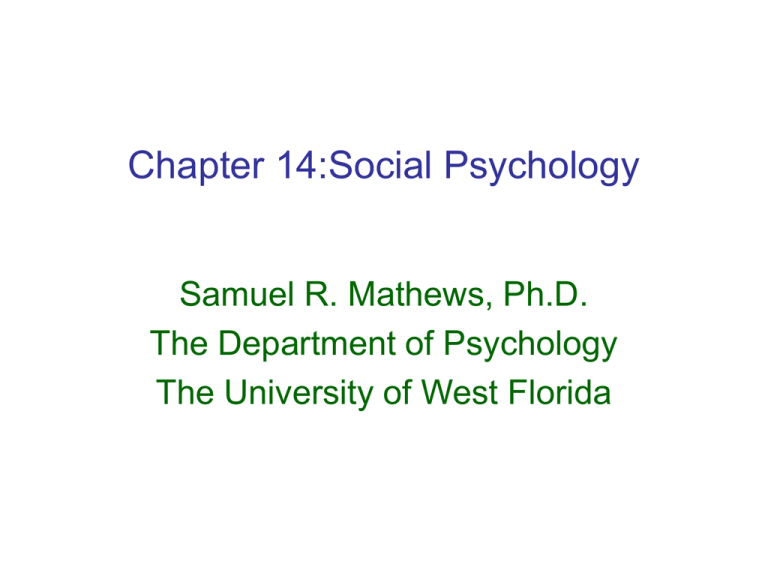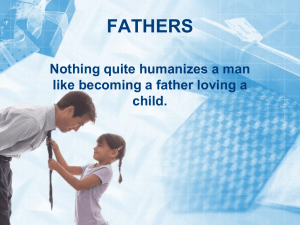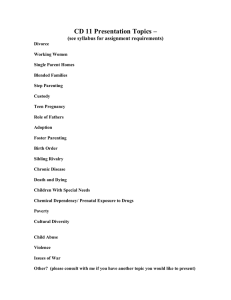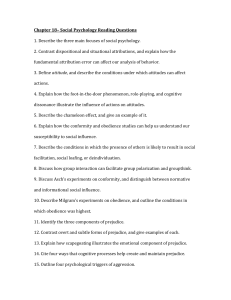Chapter 14:Social Psychology Samuel R. Mathews, Ph.D. The Department of Psychology
advertisement

Chapter 14:Social Psychology Samuel R. Mathews, Ph.D. The Department of Psychology The University of West Florida Social Psychology • Study of the impact of the social context: – Presence of other individuals (real or imagined) – Activities and interactions among individuals – Contexts in which those interactions occur – Expectations and norms governing behavior within those contexts – Resulting behaviors related to social factors AND Social Psychology • Study of the subjective interpretations of so-called real and objective situations AND • The impact of interactions between the context and interpretations on individual and group behaviors Situationism • Two forces that influence human behavior: – Individual dispositions (e.g. temperament, personality) – Social Context (e.g. people, physical environment) • Situationism is the position that the Social Context is likely the more influential Social Standards for Behavior • Consider a study by Maurer & Pleck (2006) on parenting by fathers – Investigated how fathers’ parenting behaviors were related to their subjective interpretations of: • Their wives’ stated expectations • Other fathers’ parenting behaviors • Other fathers’ comments and reflections on fatherparenting behaviors Social Standards for Behavior • Maurer & Pleck (2006) – They found that fathers’ parenting behaviors were related to: • Subjective interpretations of: –Their wives’ stated expectations –Other fathers’ comments and reflections on father-parenting behaviors – The interpretation of others’ views was the most important factor in determining fathers’ parenting behavior Social Standards for Behavior • Social Roles (e.g. Gender): socially defined pattern of behaviors expected of individuals in a given class or group • Script (e.g. parenting behaviors): knowledge of the sequence of events and actions expected of an individual within a given setting Social Standards for Behavior • Social norms (e.g. fathers’ rules for behavior): a group’s expectations about what is appropriate for its members’ attitudes and behaviors Themes in Social Psychology • • • • • Conformity (Ashe’s work) Obedience to Authority (Milgram’s work) Bystander Problem Attributions about Others Prejudice Conformity: The Asch studies • Which line matches the line on the left? A Standard line 1 2 3 Comparison lines Group Characteristics That Produce Conformity • Ashe identifies three factors that influence whether a person will yield to pressure: – The size of the majority – The presence of a partner who dissented from the majority – The size of the discrepancy between the correct answer and the majority position Conformity: Groupthink • In “groupthink,” members of the group attempt to conform their opinions to what each believes to be the consensus of the group Conformity: Conditions Likely to Promote Groupthink • • • • Isolation of the group High group cohesiveness Directive leadership Lack of norms requiring methodical procedures • Homogeneity of members’ social background and ideology • High stress from external threats with low hope of a better solution than that of the group leader Obedience to Authority • Milgram’s work: • Research on conforming to authority – Participants were deceived and thought it was a study on punishment and memory – Deliver “painful shocks” to a middle aged man who had been treated for heart problems – “Shocks” were delivered when the man gave an incorrect response – “Shocks” were increased in intensity as the trial progressed Obedience to Authority • Milgram’s study: – Middle aged man with heart condition was an actor; – Actor received no real shock – Actor began with a mild pain response, moved to a scream, then pretended to pass out – Participants willingly gave what they thought were increasingly strong shocks regardless of actor’s reactions Ten Steps Toward EvilGetting Good People to Harm Others • Provide people with an ideology to justify beliefs for actions • Make people take a small first step toward a harmful act with a minor, trivial action and then gradually increase those small actions • Make those in charge seem like a “just authority” • Slowly transform a once compassionate leader into a dictatorial figure • Provide people with vague and ever changing rules Ten Steps Toward EvilGetting Good People to Harm Others • Relabel the situation’s actors and their actions to legitimize the ideology • Provide people with social models of compliance • Allow verbal dissent but only if people continue to comply behaviorally with orders • Encourage dehumanizing the victim • Make exiting the situation difficult The Bystander Problem • Diffusion of responsibility :– Dilution or weakening of each group member’s obligation to act when responsibility is perceived to be shared with all group members The Bystander Problem • Diffusion of Responsibility – The greater the number of bystanders, the less likely any individual is to respond – Conformity to others in the group who do not respond The Bystander Problem • Overcoming Bystander Problem – Educating on the impact of diffusion of responsibility – Victim can ask an individual for help—that “breaks” groupthink/conformity – Be specific in request for help Attributions: Judgments about Others and Ourselves • Attributions about Others: – Fundamental Attribution Error: using some personal trait or characteristic as an explanation in lieu of situational constraints • Attributions about Ourselves: – Success: Self-serving bias—we are just good at _____ – Failure: External attributions to protect our own self-esteem—”the professor was unfair” Prejudice and Discrimination • Prejudice – A negative attitude toward an individual based solely on his or her membership in a particular group • Discrimination – A negative action taken against an individual as a result of his or her group membership Prejudice and Discrimination • Causes of Prejudice – Dissimilarity and social distance – Economic and resource competition – Scapegoating – Conformity to social norms – Media stereotypes Prejudice and Discrimination • Combating Prejudice – Seeking our and interacting with new role models of “out-group” – Seeking contact in an “equal status” context – Creating opportunities for interdependence – Legislation providing equal access to equal opportunities


